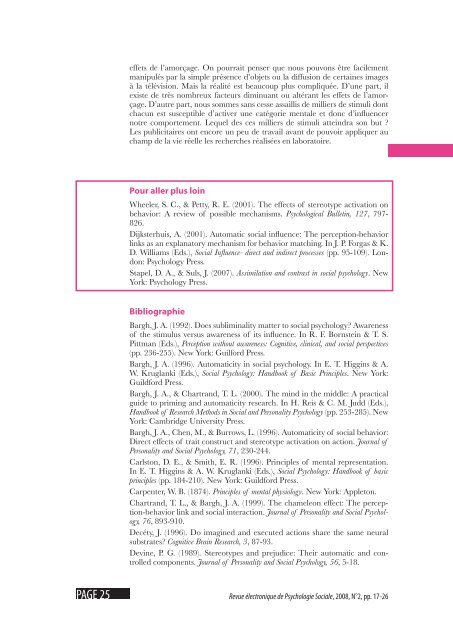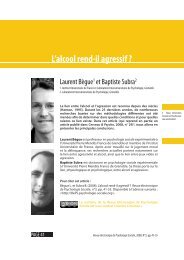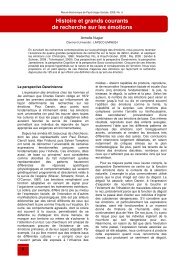Pourquoi les individus aident-ils moins autrui lorsqu'ils sont nombreux
Pourquoi les individus aident-ils moins autrui lorsqu'ils sont nombreux
Pourquoi les individus aident-ils moins autrui lorsqu'ils sont nombreux
Create successful ePaper yourself
Turn your PDF publications into a flip-book with our unique Google optimized e-Paper software.
PAGE 25<br />
effets de l’amorçage. On pourrait penser que nous pouvons être facilement<br />
manipulés par la simple présence d’objets ou la diffusion de certaines images<br />
à la télévision. Mais la réalité est beaucoup plus compliquée. D’une part, il<br />
existe de très <strong>nombreux</strong> facteurs diminuant ou altérant <strong>les</strong> effets de l’amorçage.<br />
D’autre part, nous sommes sans cesse assaillis de milliers de stimuli dont<br />
chacun est susceptible d’activer une catégorie mentale et donc d’influencer<br />
notre comportement. Lequel des ces milliers de stimuli atteindra son but ?<br />
Les publicitaires ont encore un peu de travail avant de pouvoir appliquer au<br />
champ de la vie réelle <strong>les</strong> recherches réalisées en laboratoire.<br />
Pour aller plus loin<br />
Wheeler, S. C., & Petty, R. E. (2001). The effects of stereotype activation on<br />
behavior: A review of possible mechanisms. Psychological Bulletin, 127, 797-<br />
826.<br />
Dijksterhuis, A. (2001). Automatic social influence: The perception-behavior<br />
links as an explanatory mechanism for behavior matching. In J. P. Forgas & K.<br />
D. Williams (Eds.), Social Influence- direct and indirect processes (pp. 95-109). London:<br />
Psychology Press.<br />
Stapel, D. A., & Suls, J. (2007). Assimilation and contrast in social psychology. New<br />
York: Psychology Press.<br />
Bibliographie<br />
Bargh, J. A. (1992). Does subliminality matter to social psychology? Awareness<br />
of the stimulus versus awareness of its influence. In R. F. Bornstein & T. S.<br />
Pittman (Eds.), Perception without awareness: Cognitive, clinical, and social perspectives<br />
(pp. 236-255). New York: Guilford Press.<br />
Bargh, J. A. (1996). Automaticity in social psychology. In E. T. Higgins & A.<br />
W. Kruglanki (Eds.), Social Psychology: Handbook of Basic Princip<strong>les</strong>. New York:<br />
Guildford Press.<br />
Bargh, J. A., & Chartrand, T. L. (2000). The mind in the middle: A practical<br />
guide to priming and automaticity research. In H. Reis & C. M. Judd (Eds.),<br />
Handbook of Research Methods in Social and Personality Psychology (pp. 253-285). New<br />
York: Cambridge University Press.<br />
Bargh, J. A., Chen, M., & Burrows, L. (1996). Automaticity of social behavior:<br />
Direct effects of trait construct and stereotype activation on action. Journal of<br />
Personality and Social Psychology, 71, 230-244.<br />
Carlston, D. E., & Smith, E. R. (1996). Princip<strong>les</strong> of mental representation.<br />
In E. T. Higgins & A. W. Kruglanki (Eds.), Social Psychology: Handbook of basic<br />
princip<strong>les</strong> (pp. 184-210). New York: Guildford Press.<br />
Carpenter, W. B. (1874). Princip<strong>les</strong> of mental physiology. New York: Appleton.<br />
Chartrand, T. L., & Bargh, J. A. (1999). The chameleon effect: The perception-behavior<br />
link and social interaction. Journal of Personality and Social Psychology,<br />
76, 893-910.<br />
Decéty, J. (1996). Do imagined and executed actions share the same neural<br />
substrates? Cognitive Brain Research, 3, 87-93.<br />
Devine, P. G. (1989). Stereotypes and prejudice: Their automatic and controlled<br />
components. Journal of Personality and Social Psychology, 56, 5-18.<br />
Revue électronique de Psychologie Sociale, 2008, N°2, pp. 17-26




